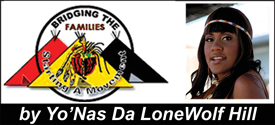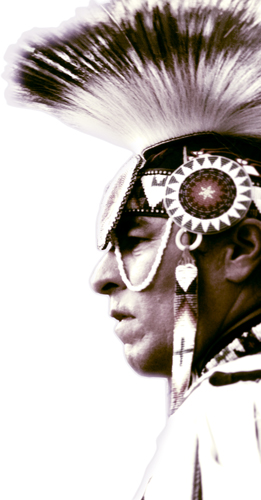‘We Are People Not A Mascot’
By Yo'Nas Da LoneWolf Hill | Last updated: Jun 20, 2014 - 5:30:22 PMWhat's your opinion on this article?

|
I would like to re-introduce myself, my name is Sis. YoNasDa LoneWolf Hill I am a proud enrolled member of the Oglala Lakota Nation from Pine Ridge, South Dakota. I am the daughter of the late activist Wauneta LoneWolf. I have spearheaded the Indigenous Nations Alliance for the Millions More Movement. One of my favorite artists, Pharrell, recently graced the cover of Elle magazine with a traditional Native American head dress or what Westerners like to call “a war bonnet.”
I received many e-mails from people all around the country wanting to know how I felt about that, mainly because I have fought against injustices perpetrated against Indigenous people over the past 10 years. I will say that as a Native American and Black woman, I am not a mascot—I am a person!

|
When I was a young girl my mother would dress me in African clothes that came from Ghana or Nigeria. My mother would get traditional fancy shawl dancer regalia made for me. When I would go to predominately Black events in my Native American regalia I would get compliments such as, “I love your costume!” I immediately feel hurt. “My costume? This isn’t a costume! I don’t celebrate Halloween!” I would think. When I would attend a Native America Pow Wow in my African regalia I would get compliments like, “Oh your clothes are cool, do you speak English? Why are you dressed like that?”
Being of both races, I experienced the same responses based on a lack of knowledge from both sides of my heritage.
Then I saw that Pharrell, Khloe Kardashian, Andre 3000, Harry Styles from One Direction, Kelis and many others that thought it would be stylishly cool and appropriate to put on a head dress with colorful feathers—well it is not! We as Indigenous people of this world are not your mascot! Every intricate detail of Native American regalia was earned and has a back story behind it. Many moons ago the head dress was earned for bravery by a male that would lead the tribe. It wasn’t made by women but by his male counterparts that bore witness to his steadfastness in leading the tribe—whether in fasting and prayer or in a brave act. Each feather was given after an achievement by that male. Some headdresses had one colored feather or many colored feathers depending on the birds in the region where the tribe resided. The headdress started from my tribe the Lakota (Sioux) and as merging of tribes began; many customs were adopted like the headdress. It wasn’t always the chief of the tribe that wore a headdress sometimes it was the chief who would make a headdress for a male who displayed an act of bravery. The strap that kept the feathers together was either leather or deer sinew.
Today the Native American headdress is worn in weddings or for ceremonial purposes not as a costume or a mascot or for a fly photo opportunity.
Pharrell did release a public apology stating, “I respect and honor every kind of race, background and culture,” said the artist, who sparked fury after posing on the cover of Elle dressed in the ceremonial garb of chiefs and warriors. Initially, Elle’s website bragged about their styling: “We persuaded Elle Style Award winner Pharrell to trade his Vivienne Westwood Mountie hat for a Native American feather headdress in his best ever shoot.” That message was later changed to read, “We persuaded [Pharrell] ... to collaborate with us on his best ever shoot.”
Even though Pharrell, like other Black Americans in the United States may have Native American ancestry in his lineage, that doesn’t excuse them from having a lack of knowledge of self. This is why it is important to not just acknowledge what races are in your family but to study their traditions and culture. Even my brother who is also Native American can’t just throw on a Native headdress and say, “But I’m Native American.” You have to earn the right to wear this regalia. There is certain traditional make up I can’t put on as a Native American woman because I haven’t earned certain symbols or jewelry or feathers. Just like in the military and as America’s government are proud of their medals and uniforms we as Indigenous people are proud as well. We are people not a mascot!
Mitakoye Oyasin.
(You can reach contributor YoNas Da LoneWolf Hill at [email protected].)
INSIDE STORIES AND REVIEWS
-
-
About Harriett ... and the Negro Hollywood Road Show
By Rabiah Muhammad, Guest Columnist » Full Story -
Skepticism greets Jay-Z, NFL talk of inspiring change
By Bryan 18X Crawford and Richard B. Muhammad The Final Call Newspaper @TheFinalCall » Full Story -
The painful problem of Black girls and suicide
By Charlene Muhammad -National Correspondent- » Full Story -
Exploitation of Innocence - Report: Perceptions, policies hurting Black girls
By Charlene Muhammad -National Correspondent- » Full Story -
Big Ballin: Big ideas fuel a father’s Big Baller Brand and brash business sense
By Bryan Crawford -Contributing Writer- » Full Story






 Click Here Stay Connected!
Click Here Stay Connected!








